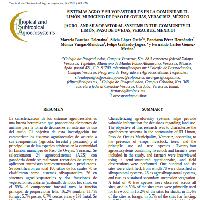Resumen
-
Characterizing agroforestry systems helps provide valuable information for decisions regarding land use. The objective of this research was to characterize the agroforestry systems in the community of El Limon, Paso de Ovejas Municipality, Veracruz, according to the presence of crops, livestock, trees, and the principle use of tree species. Twenty-four agroecosystems containing livestock and farmers were included in the study, and farmers were interviewed using a semi-structured questionnaire, and field observations were performed. One hundred and six sites were identified, from which 78 were classified as silvopastoral systems, 26 as agrosilvopastoral systems, and two as sustained secondary succession vegetation.
A total of 70 tree species were observed across all sites, and in 59% of the sites trees were primarily used for firewood, in 16.2% of the sites for shade, in 11.4% of the sites as forage, in 5.7% of the sites for fencing, in 6.7% of the sites as live fences, and in 1% of the sites for fruit production. The silvopastoral system is the most popular agroforestry system in the studied area, integrating cattle, Panicum maximum Jacq. and different dispersed tree species; followed by the agrosilvopastoral system composed of corn, cattle, and different tree species used in most cases as living fences. -
La caracterización de los sistemas agroforestales es una buena herramienta que proporciona elementos de análisis para la toma de decisiones en sistemas de uso del suelo. El objetivo de esta investigación fue caracterizar los sistemas agroforestales de acuerdo a sus componentes (agrícola, forestal y pecuario) y al principal uso de las especies arbóreas en la comunidad El Limón, municipio de Paso de Ovejas, Veracruz. Se seleccionaron 24 agroecosistemas (AES) con ganadería donde se realizaron recorridos de campo y aplicaron entrevistas semiestructuradas a productores.
Se identificaron un total 106 sitios de los cuales 78 se clasificaron como sistemas silvopastoriles, 26 en sistemas agrosilvopastoriles y dos fracciones de vegetación secundaria (acahual); de todos los sitios, en el 59% el componente forestal tuvo la función principal de proporcionar leña, 16.2% sombra, 11.4% forraje, 5.7% postes, 6.7% cercas vivas y 1% frutal. Se identificaron un total de 70 especies arbóreas nativas e introducidas. Se concluye que el sistema más común en estos AES es el sistema silvopastoril el cual está integrado por bovinos, Panicum maximum Jacq. y árboles dispersos de distintas especies, mientras que los agrosilvopastoriles están compuestos de maíz, bovinos y especies arbóreas en cercas vivas.
